 This is an Argus Autronic II, a 35mm rangefinder camera made by Argus in Ann Arbor, Michigan starting in March 1962. The Autronic II was a slight upgrade to the original Autronic 35, adding a faster f/2.8 Cintar lens and a bright frame viewfinder. The Autronic series shares a design first seen on the Argus C33, but with a fixed lens and the addition of a German Compur leaf shutter and shutter priority automatic exposure. The Autronic cameras were the only cameras ever made by Argus with AE, as later SLRs with the feature were built by other companies. The design of the camera is quite bulky, but they otherwise work quite well, offering an inexpensive and easy to use automatic exposure camera to American customers.
This is an Argus Autronic II, a 35mm rangefinder camera made by Argus in Ann Arbor, Michigan starting in March 1962. The Autronic II was a slight upgrade to the original Autronic 35, adding a faster f/2.8 Cintar lens and a bright frame viewfinder. The Autronic series shares a design first seen on the Argus C33, but with a fixed lens and the addition of a German Compur leaf shutter and shutter priority automatic exposure. The Autronic cameras were the only cameras ever made by Argus with AE, as later SLRs with the feature were built by other companies. The design of the camera is quite bulky, but they otherwise work quite well, offering an inexpensive and easy to use automatic exposure camera to American customers.
Film Type: 135 (35mm)
Lens: 50mm f/2.8 Argus Cintar coated 3-elements in 3-groups
Focus: 3 feet Infinity, Indicated by “Flash Finder” Numbers 1-8
Viewfinder: Coincident Image Coupled Rangefinder w/ Projected Frame lines
Shutter: Compur Leaf
Speeds: B, 1/30 – 1/500 seconds, Not Indicated
Exposure Meter: Coupled Selenium Cell w/ viewfinder range display and Shutter Priority AE
Battery: None
Flash Mount: Argus Flash Unit, Fully Synced
Weight: 864 grams
Manual: https://www.cameramanuals.org/argus/argus_autronic_ii.pdf
If you lived in a middle class American suburban family during the 1950s and took family vacations and required a photographic camera to capture those special moments, you probably bought a Kodak. But if you didn’t buy a Kodak, then you probably bought an Argus. And of all the Arguses that were available in the 1950s, the most common model was the Argus C3. This interchangeable lens rangefinder camera first debut in 1938 as the Argus C and received several incremental updates including flash synchronization, coated lenses, film reminder dials, accessory shoes, and several other cosmetic changes.
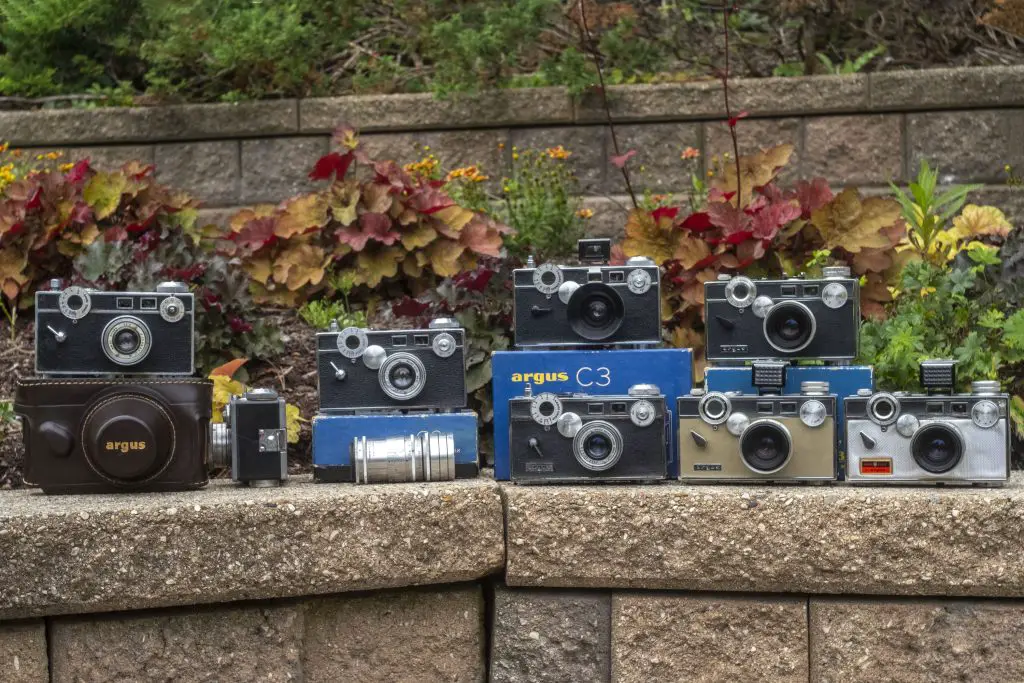
By the late 1950s, with the Argus C-series nearing two decades old, the men and women working at the Argus factory in Ann Arbor, Michigan were ready for something new. New models like the Argus C4 and C44 introduced rounded off edges with better ergonomics and larger combined image rangefinders. In 1959, with a large number of modern Arguses on store shelves, Argus decided that for their next model, they would introduce…another brick shaped camera called the Argus C33.
The C33 was marketed as a more advanced Arcus C3 and was a strangely designed camera which retained the C3’s sharp 90 degree corners, externally coupled rangefinder coupling, and heavy Bakelite body of the C3, but in a new, even more egregious design with a front panel shutter speed dial which can couple with a strange looking barrel shaped auxiliary exposure meter, a new bayonet lens mount, an awkwardly long film advance lever, and a completely out of this world bottom hinged film compartment.
The Argus C33 was an odd duck for sure, and although I could find no contemporary reviews of one, I have to imagine that most people saw this strange camera as a sort of regression in design for the company. The C33 sold poorly, and was discontinued two years after it was introduced.

Apparently, the ownership of Argus, who at this time was Sylvania Electric Products Inc, decided to double down on the angular C33 with their next camera which would debut in 1960 as the Argus Autronic C3. The use of the name “C3” was used to connect the new camera to the legacy of the venerable Argus C3 which was still being produced. Apparently, this proved to be unpopular as the two cameras shared almost nothing alike, so shortly after its release the Autronic C3 was renamed the Autronic 35.
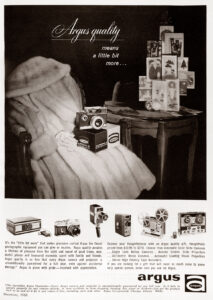
The Autronic 35 shared a very similar body design, viewfinder, and film compartment with the C33, but replaced the interchangeable lens mount and unnamed German shutter with a fixed f/3.5 Argus Cintar and a branded Compur shutter. On the plus side, for the first time ever, an Argus camera was capable of automatic exposure as the Autronic 35 featured a coupled selenium exposure meter with built in shutter priority automatic exposure.
On paper, the Argus Autronic 35 was a compelling option as one of the first 35mm rangefinders with automatic exposure and a selection of multiple speeds. Only two years before its release, auto exposure “electric eye” cameras like the Revere Eye-Matic EE 127 and Kodak Brownie Starmatic had single speed shutters and limited exposure options. At a price of “under $90” you could have an automatic exposure camera with a German shutter, a good lens, and a large, bright, and easy to use coupled rangefinder.
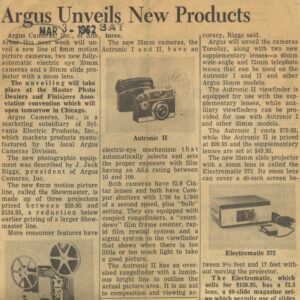
In 1962, the original Autronic model would be replaced by two new ones called the Autronic I and II. Early Autronic Is used left over parts from the Autronic 35 including the f/3.5 lens and original shutter release, but later versions would be upgraded to a faster f/2.8 Cintar lens, would extend the metering range from ASA 200 to 400, and would upgrade the shutter release button to feature a threaded cable release.
The Autronic II would feature the same f/2.8 lens, but would have an upgraded viewfinder with projected frame lines. At the same time as the release of the Autronic I and II, Argus also released two accessory lenses which would screw into the Cintar’s filter threads, changing its focal length to 40mm for the wide angle lens and 75mm for the telephoto. Although released for the newer models, they were backwards compatible with all Autronic models. With the accessory lenses, auxiliary viewfinders were also included, however support for the two lenses was built into the viewfinder of the Autronic II. At the time of its release, the Argus Autronic II had a retail price of $99.95, which when adjusted for inflation, compares to a little over $1050 today.
According to the book, Argus: Fine American Cameras, the estimated production numbers of the Autronic C3, 35, I, and II were 10,000, 90,000, 50,000 and 30,000 respectively. Production of the Autronic II is thought to have concluded in August 1964 with the Autronic I ending before that. Although it can be assumed that buyer’s preferences had changed by the mid 1960s, that Argus was shifting its focus to Japanese built cameras, could have also led to the model’s discontinuation.
It is no secret that I have a fondness for Argus cameras, especially the C-series. I have every major variant of the original C-series including the very first model with the Fast/Slow switch on the body, and apparently, my love for this brand has extended into their later, less successful models. While models like the Argus C33 and Autronics are extremely bizarre and horribly un-ergonomic, there is a certain charm to these egregious designs. Despite all common sense that there should have been a better way to make these cameras, that Argus produced brick-shaped cameras for nearly 30 years is pretty amazing. Even more so, is that once you look past their many faults, these are usually pretty capable cameras. Whether you have a model with the home made Cintar lenses, or one of the many German lenses produced for Argus cameras, these cameras often make images with pretty good quality.
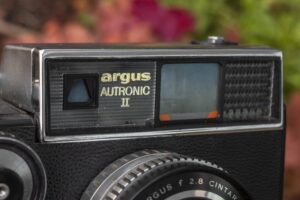
I picked up this Autronic II six or seven years ago. I had intended on writing a review for this model back in 2019 but just never got around to it. This particular example has a dead selenium cell so using it in Automatic mode is impossible, however one nice feature of the Autronics is that they can be shot manually. Despite not having any markings for traditional shutter speeds or aperture f/stops both speed and diaphragm can be manually controlled.
Around the same time the Autronics were released, Argus had created the Argus C3 Match-Matic with its unique EV system which relied in sequential numbers rather than exposure settings. Models with the f/3.5 Cintar used a scale from 3.5 to 9, and models with the f/2.8 lens went from 3 to 9, with each number being a whole f/stop smaller. For shutter speed, the Compur shutter supported five speeds from 1/30 to 1/500, but was indicated with labels like Flash, Scene, Action, and 500. The shutter also supported a Bulb mode for long exposures, but strangely, this wasn’t marked. If you want to shoot the camera manually, you just have to learn which combinations of these setting corresponds to whatever real shutter speed and f/stop you would like. For example, Scene and EV 7 actually mean 1/60 and f/11. As the selenium meter was no longer responding to light on this example, if I was ever going to shoot it, I would need to do it manually.

The ergonomics of the camera are predictably terrible. All it takes is a quick glance at the Autronic II to tell this is a massive camera with sharp corners. The Autronic II is larger and heavier than an Argus C3 in every dimension, topping the scale at 864 grams, compared to a late 1950s Argus C3 with the 50mm Cintar at 754 grams. Ergonomically, the front location of the shutter release is the exception, as it was very easy to locate, and the strange looking skinny film advance lever mostly works okay.
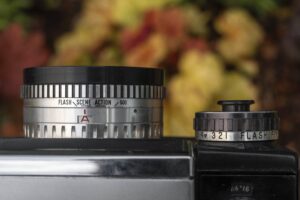
The rest of the camera can best be described as “weird”. There is almost no control or feature of this camera which works like you’d expect. For starters, the Argus Autronic II (this is true of all the models) is one of the very few 35mm cameras in which focus cannot be controlled on the lens. It is done with knob which encircles the shutter release. This knob does not have distance markings on it, rather the word “Flash Finder, and meaningless numbers from one to eight. What do these numbers mean? The manual doesn’t even tell you, other than to see that a black triangle between the numbers three and four is for 15 feet. If you find a used Autronic camera, you better hope the rangefinder is accurate as there is no other way to tell what distance the camera is focused to.
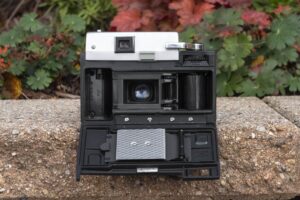
Loading film into the camera is a strange and unpleasant experience. The bottom hinged door is released by a very difficult to use plastic latch, which on my example feels like it is one step away from breaking off, never to open the door again. Once you do get the door open, the film compartment kind of looks normal, until you look at the take up spool, which rather than having slits or a clip to hold the film leader, has a tiny metal bracket which holds onto two perforations and pulls it along the outer perimeter of the spool. My first several attempts at loading the Autronic II were in vain as the film leader kept falling off this tiny clip as it does a very poor job of holding onto the film until after rotating it a couple of times. I found that when loading film, it was best to use a small piece of tape to secure the leader to the spool. Even with the leader taped to the spool, I wasted a bit more of the film with the door open to guarantee it was transporting correctly.
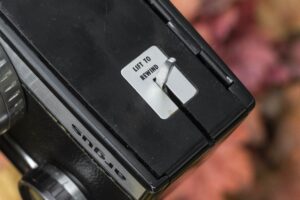
The exposure counter does not automatically reset and is accessed through a rectangular hole in the rear door. You can rotate the counter manually with or without the door open, but its awkward to do with the door shut. When it comes time to rewind film, the top of the camera has a somewhat ordinary looking rewind knob with fold out handle, but before you can rewind the film, you must deactivate the film transport by folding out a long metal ‘knife-like’ protrusion on the bottom of the camera. With this lever pulled out, it doubles as a self defense weapon as the tip is rather sharp. Why a sharp metal lever instead of a button or even a switch like pretty much every other 35mm camera ever? Who knows!
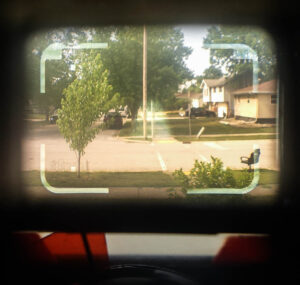
Continuing with the Autronic’s many quirks, the exposure metering system is a bit odd too. The large and bright viewfinder is easy enough to use, but the metering system relies on two red “zones” to the left and right of a visible scale at the bottom of the viewfinder. A black needle bounces between the two zones and only when it is not in a red zone can proper exposure be made. The actual position of the needle doesn’t indicate anything about exposure, other than that it is within the physical limits of the camera. Automatic Exposure is set by turning the aperture ring to a red A setting and adjusting the shutter speed using the ring with the Flash, Scene, Action, and 500 settings. On the plus side, with a working meter, it really doesn’t matter which setting you choose, as long as the needle isn’t pointing to a red zone, you should be good to go. When shooting the camera manually, you can disregard this scale.
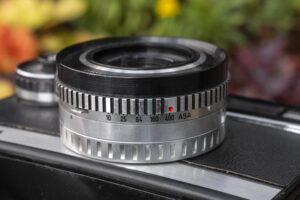
On the plus side, the rangefinder patch has nice contrast and is shaped like a large trapezoid. The projected bright lines are very bright and easy to see in all but the dimmest light. And while it is completely bizarre that nowhere on the camera are distances marked, with the camera to your eye, you can just spin the “Flash Finder” knob to align the images and once the double image merges into one and the exposure needle is not in a red zone, you can fire off a properly focused and exposed shot. For as much as I am making fun of the Autronic II’s bizarre controls, it actually does work OK and with a little bit of practice, probably did a pretty good job of returning nice color slides to original owners of this camera.
The first time you pick up an Argus Autronic, it is very easy to focus on the things that are weird about it, but if you force yourself to look at it at what it was intended to be, an easy to use camera for those with little understanding of photography who just wanted to make good photos, the strength of the camera becomes more clear. Realizing that I had a “mostly” working camera with what looked to be a working shutter, clear lens, and accurate rangefinder, I decided to load in some film and take it for a stroll. As I often do, I loaded in a roll of bulk Kodak TMax 100 and took it with me to one of my favorite photographic locations, a retired train park in Griffith, Indiana.

My knee jerk reaction to seeing the images I got from the Autronic II is to say how great they look, but I’ve gotten good looking images from other Argus cameras before, so I guess I shouldn’t be too surprised at the results. I have stated, on multiple occasions how much I love the Argus C3 and find that the combination of the user experience and results to be very good, so to see nice looking images from the f/2.8 Cintar on the Autronic II shouldn’t be surprising. Sharpness was excellent across the frame with little to no vignetting or softness near the edges. This is even more impressive considering this is supposed to be a triplet lens which would normally show some level of degradation near the edges.
If there was one issue I did notice, it is that contrast seemed to be a bit lower than I’ve come to expect from Kodak TMax 100. In some images, I saw what I thought was flare, but after further review, I think the lack of contrast is due to a presence of light bouncing around inside the lens as there wasn’t any obvious haze visible when looking through the lens with the shutter in Bulb mode. Still, the images were quite impressive.

The experience of shooting the Autronic II is….definitely interesting. If you’ve read the section above in this review, I already summarized most of the camera’s many ergonomic snafus. I’ll reiterate here that the Autronic II is one of the strangest cameras I’ve ever handled as nearly every aspect of the cameras use, from opening the rear door, loading film, setting exposure, focusing the lens, advancing the film, making the exposure, and then rewinding the film is unorthodox to most cameras, even other Arguses.

Yet the most surprising thing is, somehow, it all seems to work. That I got a roll full of mostly nice looking images on a camera with a dead meter, no way to know exactly what distance I was focusing on and trusting a 60 year old camera manual for exposure setting, suggests that Argus did something right.
Total sales of the entire Autronic series was around 180,000 units, which isn’t nothing. If the camera was too difficult to use or didn’t make good images, it stands to reason that sales should have been much less. I would even go as far as to say that if you had never seen or used a camera before, and the Autronic II was your first ever experience with a camera, you might think its many quirks was normal. Perhaps that is the secret to using the camera, forget everything you know about photography and just accept it for what it is and you’ll be rewarded with good images.

Normally, at this point in a review I’d offer a few suggestions on things that could make the camera better, but the Autronic II is so strange, I feel that somehow improving even one thing would put the entire camera into a tailspin into unusability. Sometimes its better to just leave things be.
When it comes to collecting and using old cameras, I find the ones which are the most interesting are the ones that are the most different. Who wants to shoot the same basic camera formula over and over again? Collections should have a variety. Taking into account the whole Autronic II experience, perhaps this is the most collectable camera out there! If you are a fan of strange and unusual cameras, run, don’t walk, to your nearest eBay terminal and pick one up. The prices on them are quite low, and as an added bonus, if you decide to put some film through one, you will be rewarded with some decent looking images!
Related Posts You Might Enjoy
External Links
http://camera-wiki.org/wiki/Argus_Autronic_35



















I’m impressed you got one of these to work. The wind lever is connected to a fine nylon cord which wanders through the camera body and eventually cocks the shutter. Most of the ones I’ve seen, this cord is broken and I assume they had some special jigs and tools at the factory to install it, as I’ve never had any luck replacing one.
The 1-8 numbers on the focus wheel are for using flash bulbs. With normal film speed (whatever that was in the early ’60s) you set the shutter to flash and the aperture dial to the number that matches the one on the focus wheel and your flash pictures should be properly exposed. The Matchmatic C-3 has a similar system.